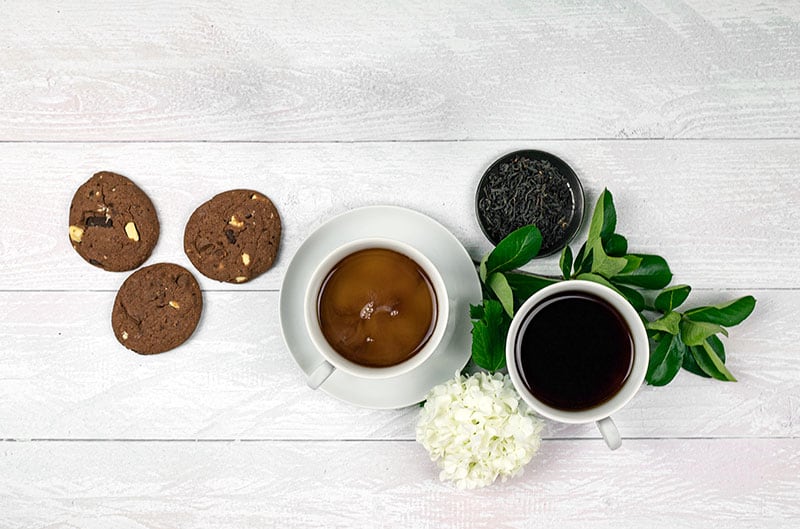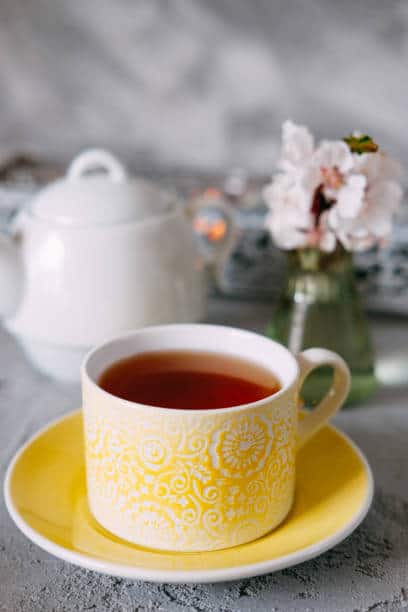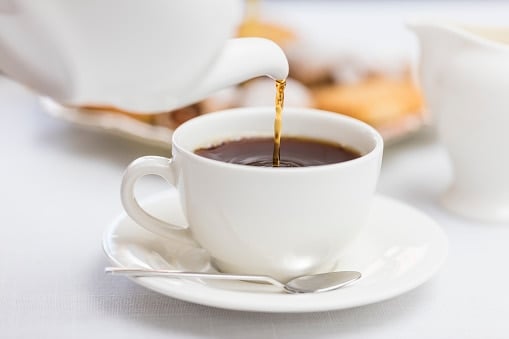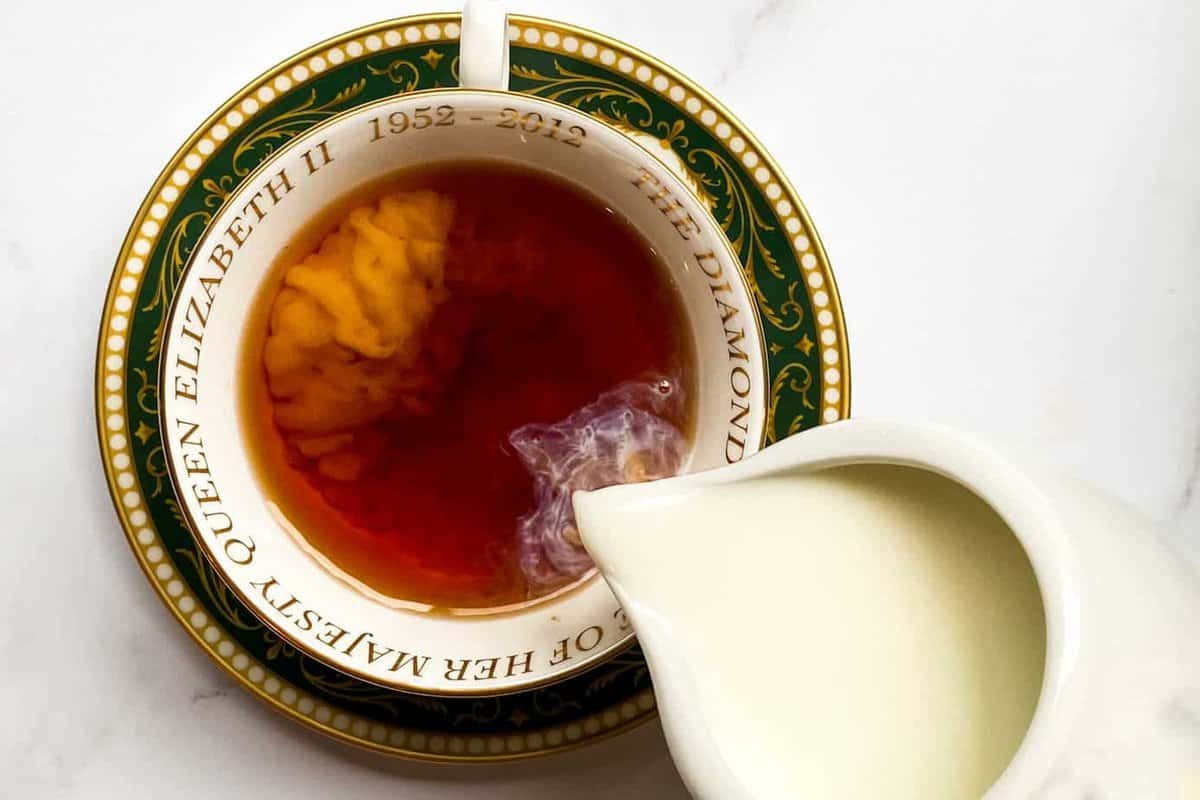Breakfast tea is designed to be served with a hearty breakfast, but there are different variations in different parts of the world. The differences between English Breakfast Tea and Irish Breakfast Tea are subtle, but when you know what makes them unique, you can make the best selection for you!

Breakfast teas are a rich blend of black teas meant to be enjoyed with a warm, full breakfast. They are a perfect alternative for those who don’t like the strong flavor of coffee but still want something warm to drink in the morning.
There are several different types of breakfast teas served in different regions, and while a novice tea drinker may not recognize the difference, those who enjoy tea on a daily basis may appreciate being able to distinguish the flavors.
Once you have tasted both, you can better determine your preference. If you have a love for tea and a desire to understand exactly what is in the blend you are drinking, you’ve come to the right place!
What is Breakfast Tea?
Breakfast Teas are black tea blends that are intended to be made strong and served with milk. They work well to balance out a protein-rich breakfast like the ones served in England and Ireland.
You may be able to find decaffeinated or herbal breakfast tea, but traditional breakfast tea is noted for its high caffeine content and is strictly black tea. The caffeine in breakfast tea provides a nice boost to get you going in the morning!
Breakfast tea is typically dark in color with a strong flavor that is not bitter and pairs well with milk and sugar.
There are many breakfast tea blends available for sale, but the most common are English, Irish, and Scottish.
Breakfast tea blends usually contain black tea from several different countries including China, Sri Lanka, Assam, Kenya, and Indonesia. There is no official standard for what a breakfast tea must contain so even among different brands you will probably notice a difference, but there is an expected difference between English, Irish, and Scottish breakfast teas. You can find all of these blends sold as loose leaf tea or in tea bags.
Origins of Breakfast Tea

There are a few different stories about how breakfast tea came to be. English breakfast blend is thought to be the original but despite the name, it was not created in England.
The most common story is that a Scottish tea maker named Robert Drysdale was the first to mix up a breakfast blend. During a visit to Scotland in 1892, Queen Victoria tried the tea and enjoyed it so much, she brought it back to England with her.
Another theory credits an English immigrant living in America in 1843 with the invention. He began to sell his own loose-leaf mix and it became incredibly popular among tea makers.
The last story is that in the early 1700s Queen Anne asked for a lighter tea to accompany the heavy breakfast that was enjoyed throughout England at the time which often consisted of eggs, beans, meat, bread, and ale. Breakfast tea was created and soon became popular across England.
No matter the story you hear, most tea experts agree the first breakfast tea was likely a Chinese tea called Keenum. Over time black tea has been produced in India, Sri Lanka, Africa, and China, and today many breakfast teas are a blend of each.
The region the tea comes from changes the flavor drastically, and the amount of each type of tea also makes a big difference in the taste.
English Breakfast Tea

English Breakfast Tea is thought to be the first breakfast tea and therefore has become the most popular. It is the lightest of the breakfast teas and has a bright flavor.
Caffeine levels may vary from one tea maker to another, but most English Breakfast Teas have about 30-60 milligrams of caffeine in each cup which may be less caffeine than other varieties.
English breakfast tea is most commonly made of Ceylon tea from Sri Lanka with a bit of Assam tea. It may also contain Keemun tea from China, which is floral, woody and slightly smoky.
Irish Breakfast Tea

Irish breakfast blends have a stronger flavor than English breakfast tea and are described as being malty.
Its distinct, bold flavor comes from Assam tea, named after the region it is produced in. This also gives it a reddish color and a slightly more bitter flavor. This full-bodied tea is typically most appealing to coffee drinkers, but it only contains about 40 milligrams of caffeine in each 6-ounce cup of tea.
This strong tea is almost always served with milk and sugar, but some tea drinkers enjoy it on their own. In Ireland, it is enjoyed all throughout the day.
The main difference between Irish breakfast tea and British breakfast tea is the strength of the flavor. If English tea is not strong enough for your taste buds, you might consider giving Irish breakfast tea a chance.
Scottish Breakfast Tea

Scottish Breakfast Tea is a good middle ground between English and Irish breakfast teas and contains mostly Assam and Kenyan tea.
Scottish breakfast tea is not as easy to find as English and Irish blends. It was designed primarily to taste good in Scotland’s soft water, which doesn’t contain as many minerals as in other parts of the world.
It has a malty flavor like the Irish blend but is not as strong.
FAQs
Breakfast tea is meant to be enjoyed with a splash of milk and sugar. It has a robust flavor that is softened by a bit of milk, however, it’s up to the individual’s preference. Many people enjoy breakfast tea on its own or with sugar only.
While Earl Grey is often enjoyed in the morning, it is not considered a traditional breakfast tea. It is a black tea, but it has a lighter flavor than traditional breakfast tea. Its light, citrusy flavor (which comes from bergamot oil) makes it a good choice for any time of day.
It’s not a good idea to drink tea on an empty stomach. Tea is acidic which can cause indigestion to an empty stomach. Breakfast tea was designed to be enjoyed with a full, hearty breakfast with plenty of protein.
There are many health benefits to drinking tea daily. Black tea is full of helpful antioxidants including flavonoids, lipoproteins, potassium, and magnesium, which can help prevent heart disease, diabetes, and even cancer. On its own, it contains no calories or fat. Tea is also considered to be good for your gut as it promotes good bacteria growth.
Breakfast tea blends also contain caffeine which can give you energy that improves focus and increases energy levels. Too much caffeine can be harmful and increase a person’s anxiety, but tea is considered a healthy alternative to coffee because it contains less caffeine than a cup of coffee. Six ounces of coffee contains 70 milligrams of caffeine while a cup of Irish Breakfast Tea contains only 40.






Leave a Reply